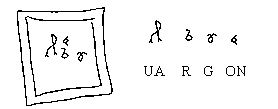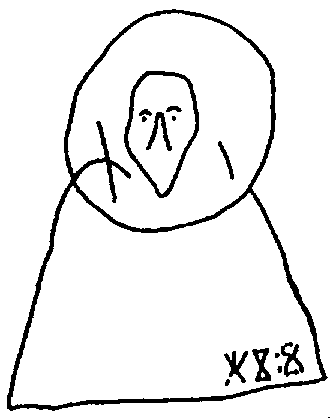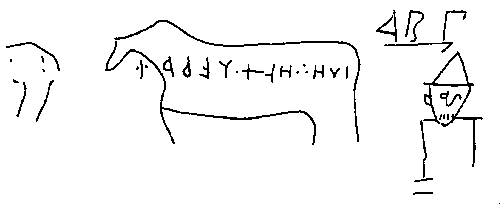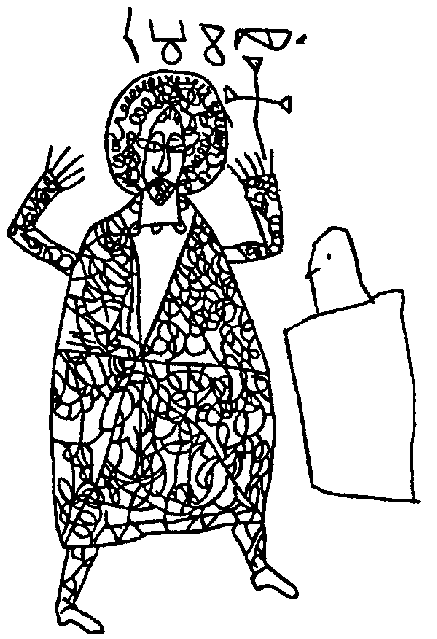
4. General Overview of the Inscriptions from Murfatlar
The reading of the runic inscriptions is particularly assisted by some Slavic inscriptions carved nearby on walls in Murfatlar, in Pliska and Preslav. Here special runes accompany the Slavic letters (see Supplement 2, inscription 4; Supplement 6, inscription 1 and 2; Supplement 7).
The Slavic inscriptions allowed the deciphering of 7 of the old characters. It can be safely stated that the decoding is correct, because the Slavic inscriptions demonstrate how each of these seven characters sounded like. But the Slavic inscriptions from the early Cyrillic centres of our country cannot help in reading the entire runic alphabet. Hopefully, most of characters from Murfatlar appear in other, older alphabets.
Particularly helpful for the interpretation of the inscriptions of Murfatlar, Pliska, Ravna, Krepcha is the existence of similar inscriptions from Southern Ukraine and Caucasus. In one of them Acad. G. Turchaninov read these two indicative words: ALANUI KAN, i.e. the "Khan of the people Alans", "the ruler of the Alans " (see Speech and written monuments of the peoples of the North Caucasus and Eastern Europe, G. Turchaninov. L., 1971). This inscription contains the highest Proto-Bulgarian title KHAN, written with runic characters of the Murfatlar type. Another point of interest is that the Alans are well-known as people, once closely connected with the Proto-Bulgarians. Since the V-VI century AD they lived together with the Proto-Bulgarians in Southern Ukraine and in Caucasus. It is not a coincidence that the high ruler of the Alans bore the Proto-Bulgarian title KHAN. Likewise, the similarity of the Ukrainian characters with that of Pliska and Murfatlar, the areas, in which Asparuh set foot, is not coincidental.
The close political and cultural relations between Alans and Proto-Bulgarians suggest the application of the already deciphered Ukrainian inscriptions as a key for those from Murfatlar. For example, it is not difficult to recognize that six out of the seven characters in the inscription ALANUI KAN are also found in Murfatlar.
Beside the Alans, the Kassogs, another people once living close to the Proto-Bulgarians, had also an alphabet of Murfatlar type. VII c. Armenian sources mentioned that the people "Kash" (the Kassogs) live "between the Bulgars and the Pontus", i.e. in the area between that of Kubrat Bulgaria and the Black Sea. The Kassogs were therefore also close neighbours of the Alans. That is why there is close similarity between the Alanian inscriptions, discovered along the lower course of Don, the Kassogian inscriptions between Don and Kuban, and the Proto-Bulgarian runic inscriptions from Murfatlar. In one of the Kassogian inscriptions G. Turchaninov read the title KHAN KAISIHI, the word KHAN being written in exactly the same way as in the inscriptions quoted above. Seven out of the ten characters of the Kassogian inscription appear in Murfatlar, two more - of a somewhat modified appearance.
The Alanian, Kassogian and Ossetian inscriptions helped to interpret 20 Murfatlar characters. Adding another seven characters from the Slavic characters, we have almost the whole runic alphabet of Murfatlar deciphered.

Figure 2. The Proto-Bulgarian runic
alphabet
1. The first inscription we would want to consider consists of only four characters. It contains a very important message and it is accompanied by a drawing, which facilitates significantly the interpretation.
The drawing, which accompanies the inscription, consists of two, drawn one into another rectangles:

The leftmost character is the largest one, the inscription starts with this character and it is read from left to the right. It is untypical for the Turkic but typical for the inscriptions from former Kubrat Bulgaria. Another important feature is that one character is above the others. Such a way of writing may look somewhat peculiar today, but it was quite common in antiquity. It occurs both in Greek handwritings and in Proto-Bulgarian texts. In our case probably the reason for that is that the recorder had reached the encircling double line and he had to find a place for the fourth character. For the moment it is only a hypothesis, however it can be safely stated that this character is also part of the inscription.
In the Kassogian alphabet the first character is a special vowel which sounds as "ua". This vowel reminds of the sound "oa" of the word "zoapan", found on the Proto-Bulgarian treasure by Nagy Saint Miklos. The next character is, likewise, quite common in the Alanian and the Kassogian languages. It denotes the sound "r". The same character not as "r" but as "l" appears in some Caucasian alphabets - for example in the writings of the Caucasian Alans and in one version of the Georgian alphabet. The differences in its sound value are explained by its origin as an Aramean character, which denoted different sonar consonants - r, l and n. In our case it indicates the letter "r". That is not only underlined by the Alano-Kassogian appearance of the entire inscription, but also by the fact that in the Glagolic alphabet, once very common in our areas, the sound "r" was expressed by exactly the same character.
The third character of the inscription is easily interpreted, since
it had been inserted into one of the Slavic texts of Murfatlar in the place
of the Old-Bulgarian "g". In that inscription (see Supplement
2, inscription 7.1), the word "svjatogo" is written as  ,
i.e.
,
i.e.  replaces the Cyrillic "g".
replaces the Cyrillic "g".
In the texts discovered by G. Turchaninov, the fourth character  is met quite often and its sound value is "an" or "on". That is, in this
case we also have a character of Alano-Kassogian type.
is met quite often and its sound value is "an" or "on". That is, in this
case we also have a character of Alano-Kassogian type.
The whole word sounded probably as "uargan" or "uargon" (see also the list of the sound values of the runes in Figure 2). There are some important reference points to the meaning of "uargon" or "uargan" from the rectangular frame in Murfatlar. Among the descendants of the Alans - the today's Ossetians, the word "uardon" means a 'church, sanctuary'. In the southern parts of Central Asia - exactly those areas, that was once inhabited by the Proto-Bulgarians before their settling in Europe, the word "arkon" has the same meaning as the above Ossetian word - a 'church, sanctuary'.
The two drawn one into another rectangles framing the inscription could represent the geometrical plan of a building. Interestingly, buildings with such geometrical forms - two nested one into another rectangles, are discovered in the areas, once inhabited by the Alans and the Proto-Bulgarians. Five such buildings are known - two in Madara and Pliska, two in Southern Ukraine and another one in Caucasus, in the ruins of Humarin. These buildings were once churches and sanctuaries. The space framed by the double rectangles contained the altar with the holy fire. The book "History of the peoples of Northern Caucasus" (M., 1988, p. 135) contains valuable data about this type of buildings. The zoroastrian temples of the fire had exactly the same appearance and the building with two inserted one into another rectangles, discovered in Humarin, is certainly a zoroastrian temple.
2. The next inscription appears next to a drawing, depicting quite clearly a person in church garbs, with a halo around his head (see Supplement 3, drawing 1.3):

His right raised hand holds a large cross, and above it there are four characters:

All characters have direct parallels from Kubrat Bulgaria - the first
character correspond to the local U, pronounced as "iu" and "io". The second
-  , is the same as the Kassogian letter D,
and it sounds as "on". The third, corroded and only partially preserved
character is "e", and fourth is the Alano-Kassogian "e" again. The inscription
reads IOANE E and obviously refers to a saint IOAN (John). It remains to
clarify only, to which saint (because there are several saints with that
name) the inscription referred to.
, is the same as the Kassogian letter D,
and it sounds as "on". The third, corroded and only partially preserved
character is "e", and fourth is the Alano-Kassogian "e" again. The inscription
reads IOANE E and obviously refers to a saint IOAN (John). It remains to
clarify only, to which saint (because there are several saints with that
name) the inscription referred to.
The saint in the drawing holds a cross in the hand - a rather large cross, reaching the inscription. This remarkable cross stands out in the drawing and points that the saint in question was John the Baptist. The high raised cross is a characteristic attribute of this saint in the traditional icon painting. Therefore this drawing is an early (perhaps even the earliest) representation of John the Baptist in Bulgarian sources. As the characters from Murfatlar precede the spreading of the Slavic writing, it refers most likely to the time immediately after conversion to Christianity. Thus the walls of Murfatlar reflect the most important event in the First Bulgarian Empire - the conversion to Christianity.
3. Another interesting drawing represents again a saint, surrounded
by a large halo and the following inscription in its garb:  (see Supplement 3, drawing
1.2):
(see Supplement 3, drawing
1.2):

The colon suggests it consists of two words - G. Turchaninov already proved for the writings from Kubrat Bulgaria that the colon played the role of a separator. The starting character is read as "SI", the next character is "e", so that the first word is "SIE", i.e. holy. Behind the word "SIE" is hidden the old eastern term SI (GOD), used by the Assyrian and Old Syrian civilizations besides the designation AN. The shape of the character also reminds the representation of the god Sabbath and the halo is significantly larger than the other halos. The second interpretation is personally preferred by the author.
4. Another interesting inscription accompanies a drawing discovered in Ravna (kindly provided by Prof. M. Moskov). The drawing depicts a horse and the following inscription is read from the head to the tail: ALASHUARTTUI (see Supplement 4, drawing 2).

The characters resemble these found by Turchaninov, they are particularly close to the so-called Old Ossetian alphabet, which contains all of them. The first word ALASHU is also still common in these areas. In the northern Caucasian languages - Kabardinian, Ossetian, Adigian and many others, it means a stallion, a pure-bred horse, while for the neighbouring Turkic Kazahs it means nag. It is interesting that the Chuvashian word "lasha" has the same meaning as ALASHA - a mount.
The second word of the inscription - ART, likewise appears in North Caucasus. In Ossetian and Chechenian it means a "horse race". The entire expression ALASHU ART TUI can be translated with the help of these languages as a Holiday of horse races. The Ravna inscription was probably born in one of the traditional days of horse races organized by the Proto-Bulgarians, they have been preserved in the form of the modern Todorov-day in the Bulgarian tradition.
5. Another inscription from Murfatlar below a drawing of an early christian cleric, points on an Old Bulgarian environment. It represents a Christian clergyman in church garbs with a halo and the word FATHER in Proto-Bulgarian runes above him (see Supplement 3, 1.4).


FATHER
The first character corresponds to the letter O, because it replaces in other places in Murfatlar the Cyrillic O. The other three characters have parallels in the table of Turchaninov.
6. In another place the word Father (OTEC) is written as OTES. Next to it there is a short word which can be read as "khan" or "ghan:

We do not know what did "khan"/"ghan" mean, one could associate it with the Proto-Bulgarian "KHAN" and also with the fact that one of the Bulgarian Khans - BORIS, abdicated and assumed an ecclesiastical post. "Khan otes" could mean "THE KHAN - FATHER", but it is only a hypothesis.
7. The important spiritual role of Murfatlar with its four churches during the epoch of the formation of the Bulgarian culture, is also shown by the other preserved on its walls inscriptions. Unfortunately, some of them are poorly preserved, but even the fragments are indicative. The first line of one inscription, for example, is almost missing but in the second line we can read SIO KOSR:

The first word corresponds to the ancient SI (God, saint), while the second one - to the Iranian KASR (temple, church), which could be expressed as KOSR in some eastern languages. In the Celtic languages the substitution of R with L produced the word KASL (castle). SIO KOSR probably meant a "holy temple", beneath it another line reads:

Above these two lines is the preposition AB (see Supplement
3, inscription 20). The whole inscription can be translated
as:
IN THE HOLY TEMPLE HOLY OATH .
8. The last inscription of this type is rather long but very
poorly preserved. What remained can be interpreted with the help of the
Alano-Kassogian alphabet (particularly its Talysh version). It contains
a passionate ecclesiastical message, written by a cleric devoted to the
Christian idea:
THE SOWING OF THE HOLY TEMPLE OF GOD - wrote he - WATERS AND FEEDS
LIKE AN IRRIGATOR THE DRYNESS (see Supplement
3, inscription 13):

Almost all words are eastern Iranian in origin:
KNISHE=KNISH (seed, sowing, growth, Celtic knith)
SIP=SIP (holy, clean, bright)
EFE=EFE (Resurrection)
HSA=(Christ, the Christianity)
UVMA=OV (water), ovd (lake) Talysh, Mundjan uv (wet),
etc.
OAPO=VAFO (exactly as) - Talysh
II = IE (make) - Dardic
OZHZHE=OUZHI, OVCHI (irrigator) - Talysh
SAPE=SAPE (drought) - Talysh
Some words have Celtic parallels: KNISHE (seed, sowing) - KNITH, AVE
(God), SUV - (holy, charmful). But overall the inscription is eastern Iranian
and not Celtic in character. Another important moment is that the characters
in this inscription are particular for the Central Asian version of the
Alano-Kassogian alphabet.
9. The most interesting and rather long inscription reveals the Proto-Bulgarian views on heaven and the celestial bodies (see Supplement 3, inscription 14). It consists of ten words with the character SH in the middle designating the name for the week.
All characters have Alanian and Kassogian parallels:

The first word is the already known AN (Heaven), although in a somewhat different form - UAN, which was probably developed on eastern Iranian or Celtic base. The ending CHU reminds of the Proto-Bulgarian endings SHU and SHI from other inscriptions and UANCHU probably means "IN THE HEAVEN", "CELESTIAL". The next word probably means sun or a star, it occurs in the Iranian languages under the form SHUN, and in Celtic and English as SUN (or SAN). The number after it points that the inscription refers to celestial bodies, stars.
The rest of the text is even more interesting. We meet the word ISI, also used in other inscriptions from Murfatlar in the sense of a "ruler, master". The next word resembles the widely spread ancient term for Jupiter - JEN, JAN. A similar name for Jupiter is still used in the Celtic languages. In the Bulgarian tradition Jupiter carries the name JANKUL, it is similar to JEN of this Proto-Bulgarian inscription. The separated by a colon letter ZH denotes a number - the number 7. The same letter was used for the number 7 in the Glagolic alphabet.
All words of this longest runic writing have Iranian and Celtic parallels:
UANCHU: Sanskrit vankaia (moving by itself), vanku (mobile,
moving in the sky), an (God - Sumerian).
SAN: Dardic sun (bright), Tadjik shun (shining),
Celtic sun, san (star).
SH: seven (designation of a number).
SI: Assyr.-Babyl. si (God, Master), Sanskrit is
(ruler).
UON: Celtic eon (sun), Sanskrit. ina (powerful).
(I)NE: ine (these) - a form, common to Sanskrit, Iranian
and Celtic.
UO: IO (Jupiter) - Celtic
OS: eos (time, age) - Celtic, Assyr., Sanskrit
ISO: is (ruler, master).
IN: in (to lead, to arrange) - Celtic, Irano-Sanskrit
With the help of these words the inscription can be translated as follows:
THE MOVING HEAVENLY BODIES ARE SEVEN. THEIR RULER IS THE SUN (or IT LEADS ITSELF) AS WELL AS JUPITER - THE MASTER OF TIME.
The inscription reveals the conception of the sun as the most important celestial body. Jupiter occupies the second place as a "master of Time". In our folk tradition Jupiter is really seen as a master of the time i.e. as a star spinning the thread of the years. J. Valchev published valuable ethnographic materials, which contributed much to the clarification of the Bulgarian folk calendar. The inscription tells us something what was known only indirectly previously - Jupiter's movement formed the basis for the Bulgarian folk calendar. Jupiter was called "master of the time" by various ancient peoples. About that speak a series of texts discovered in Assyro-Babylonia, which probably reflect a Sumero-Accadian conception. It is interesting, for example, that the last eleven days of the year (the so-called "Sakmuk"), which were particularly respected and which were used to correct the inaccuracies of the moon calendar, were called "days of Jupiter" in Babylon.
Jupiter was subordinated to the sun which was called the lady of Jupiter. That again proves that for the Proto-Bulgarians it was the sun, and not as many authors assume - the moon, which served as a basis for time measurements. When we look at some old calendars resembling the Proto-Bulgarian one, it will become clearer why the sun was called "lady of Jupiter". In my last book "The Proto-Bulgarians" I pointed out that the calendar of the Central Asian Sakas, once Proto-Bulgarian neighbours, calculated in which constellation will Jupiter occurs during sunrise. Owing to the Arab astronomer Birum the formula for these calculations was preserved. It is thus clear that the old astronomical conceptions involved both the sun and Jupiter in the time calculations.
But the calculation itself as it is to be seen from the Sakas' calendar and also from our inscription, was performed in solar years and therefore the sun was called lady of Jupiter.
One part of the terms used in this inscription is so old that we must look for their roots not only among the Iranian and Indo European languages, but in but in the epoch of the Sumerians. Thus the word ION used for the sun, resembles the words ON and EN for the highest God of the heaven. The word IS - (ruler. gentleman) resembles the Sumerian word ISIN and the Accadian word ISU (powerful, strong), and the name of Jupiter IU, called in our inscription "master of the Time" - the Sumerian word U (day, time) and the Accadian word UMU (time).
All this shows that the inscription was closely connected with the old civilizations of the Near East. Its most important terms have developed in a very old epoch.
[Previous] [Next]
[Back to Contents]